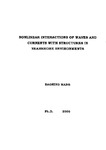Nonlinear interactions of waves and currents with structures in nearshore environments
| dc.contributor.author | Wang, Baoxing | |
| dc.contributor.other | Faculty of Science and Engineering | en_US |
| dc.date.accessioned | 2013-09-16T11:37:43Z | |
| dc.date.available | 2013-09-16T11:37:43Z | |
| dc.date.issued | 2006 | |
| dc.identifier | NOT AVAILABLE | en_US |
| dc.identifier.uri | http://hdl.handle.net/10026.1/1752 | |
| dc.description | Merged with duplicate record 10026.1/860 on 22.03.2017 by CS (TIS) | |
| dc.description.abstract |
In this thesis, nonlinear interactions of waves and currents with structures in nearshore environments are investigated. The emphasis of the research is to model the encountered multiple scales of hydrodynamics (e. g. monochromatic waves and three-dimensional currents) in a numerically efficient and accurate way on a beach and around a structure in the shallow coastal region. The radiation stress and mass flux have been analytically derived by inclusion of higher-order surface elevations. The Boussinesq-type model COULWAVE is used to assess the fully nonlinear wave transformation on a beach. The research unveils the essential roles of the Ursell parameter, Irribarren number and wave steepness described by the local wave height, wave length and bottom slope. Based on the numerical simulations, the radiation stress and the mass flux are statistically formulated. The study has shown that the importance of wave nonlinearity in wave-induced currents and mean water level. The nonlinear transformations of wave profiles produce lower radiation stress and mass flux than linear waves. Case studies suggest the nonlinear formulations produce accurate predictions for mean water levels and current profiles both inside and outside the surf zone on a beach. The new formulations also incorporated in the improved SHORECIRC model to predict current circulation in the vicinity of one or more shore-parallel coastal structures. The simulation accuracies are demonstrated by comparisons to the experimental data from the G8 Coastal Morphodynamics Programme. The model successfully reproduces a large eddy in the region sheltered by a structure. By inclusion of nonlinear integrated wave properties, the predictions of mean water levels and currents have been greatly improved. Analytical, numerical and experimental investigation of oblique wave transmission at low-crested structures is also presented. 7be two-dimensional transmission equation is constructed and validated against the laboratory data of the EU-sponsored project, DELOS. The roles of wave-breaking, nonlinearity, currents and set-up in determining the wave transmission are demonstrated. Wave nonlinearity and wave-induced currents lengthen wave-propagating distance compared to the normal waves, and lead to less transmission on the leeside of a smooth breakwater. Due to the decreased wave amplitudes and mean wave periods after transmission, the phase velocities slow down and cause the change of mean wave direction on the transmission side. | |
| dc.language.iso | en | en_US |
| dc.publisher | University of Plymouth | en_US |
| dc.title | Nonlinear interactions of waves and currents with structures in nearshore environments | en_US |
| dc.type | Thesis | |
| plymouth.version | Full version | en_US |
| dc.identifier.doi | http://dx.doi.org/10.24382/4284 |
Files in this item
This item appears in the following Collection(s)
-
01 Research Theses Main Collection
Research Theses Main


